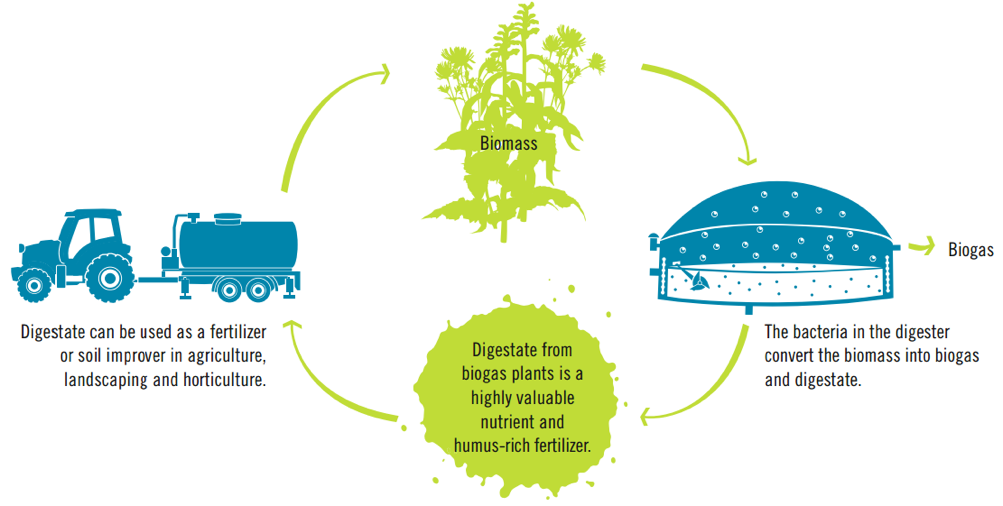Organic fertilizers include mainly carbon materials of plant and / or animal origin[1]. The most common types of agricultural organic fertilizers are all types of manure and litters, crop residues, siderates. Digestate from biogas plants is also an organic fertilizer that can contain all the listed types of organic materials in the converted form.
The recycling of organic materials to land is considered as the best practicable environmental option in most circumstances, completing both natural nutrient and carbon cycles. Organic materials are valuable sources of major plant nutrients (i.e. nitrogen – N, phosphate – P2O5, potash – K2O and sulphur – SO3), which are essential for plant growth and therefore sustainable crop production.
Organic materials also provide a valuable source of organic matter, which improves soil water holding capacity, workability and structural stability etc.
However, the return of organic material to the soil must be controlled from the point of view of both the agro-technical effect (application must be balanced according to the type and condition of the soil, the cultivated crop, etc.) and the environmental effect (application should not lead to deterioration of sanitary- epidemiological status, soil and groundwater contamination, etc.). Therefore, the use of pre-treatment technologies for organic materials is appropriate, and in some cases necessary.
Anaerobic digestion technology is one of the most rational ways to treat different types of organic materials, including agricultural origin.
Digestate reduces the potential for soil erosion and improves productivity byincreasing the soil organic matter and soil fertilityand supplying additional nutrients.Anaerobic digestion technology is essentially an important link in organic recycling in agriculture (Figure 1).

Figure 1 – Raw material – digestate cycle[2]
Digestate is normally used as fertilizer for crops without any further processing, substituting industriallyproduced mineral fertilizers. However, the need for efficient nutrient management, required by restrictions on manure application in areas with high livestock density, along with depletion of the global natural reserves of phosphorous and potassium, make recovery and recycling of plant nutrients from manure, waste streams, and other resources increasingly important for farmers, technology providers, investors, and decision makers[3].
Effective use of organic materials, including digestate based, is extremely relevant in Ukraine. The developed agro-industrial sector of Ukraine’s economy with a large share of agricultural land requires considerable amounts of fertilizers. Actual management practice and land ownership during the years of Ukraine’s independence have had a negative impact on soil fertility, which is resulted in the loss of large humus proportion, imbalance of nutrient content, soils acidification and alkalinity, deficits of mobile forms of phosphorus, potassium and microelements, chemical and radiation pollution, and erosion[4].The reasons for this conditions of soil are found in particular in intensive production with the dominant use of mineral fertilizers and the critical fall in the volume of organic fertilizers application.
Increasing of organic fertilizers application into the soil is possible in the following main ways:
- Increased volume of manure/litter, which in turn requires an increase in livestock population;
- Increase in the share of crop residues introduced into the soil.
- Return of nutrients with residual / waste streams after primary agricultural products treatment (urban food waste, by-products of the food processing industry, substandard crops, etc.).
- Utilization of the potential of abandon land potential unsuitable for traditional agricultural production, for the production of plant biomass (perennial grasses), which can be used for arable land application.
- Use of the potential of meadow land and lawns for green biomass harvesting and application onto arable land.
Considerable growth of animals population, given the current trends in Ukrainian livestock breeding, is unlikely. The use of residues / wastes after the treatment of primary agricultural products as organic fertilizer can only be possible after pre-treatment with different bioconversion methods, incl. composting and anaerobic digestion, and production of complex organo-mineral fertilizers. The use of biomass from degraded land and grasslands is also advisable under condition of pre-treatment (composting, anaerobic digestion).
The introduction of large amounts of crop residues into the soil as a fertilizer has certain limitations, which include the need to apply nitrogen fertilizers to balance the C:N ratio and the need to regulate the acidity due to release of organic acids after breakdown of straw in the soil. According to the data of Ukrainian Ministry[4], one ton of crop residues at fertilizer value is equivalent of three tons of manure; however, equivalent of 22-25 kg of nitrogen fertilizers must be applied for each ton of crop residues for nitrogen compensation. Improvement of plant residues and manure humification is possible both by agrotechnical measures implemented directly in the soil, as well as by pre-treatment with bioconversion methods, incl. composting and anaerobic digestion.
Authors: Petro Kucheruk, Yurii Matveev – experts of Bioenergy Association of Ukraine
[1] National Standard of Ukraine: DSTU 4884: 2007 Organic and Organic Mineral Fertilizers. Terms and definitions »/ State Consumer Standard of Ukraine. – Kyiv, 2010. – 34 p.
[2] Digestate as fertilizer. German Biogas Association. Deutsche Gesellschaft für Internationale Zusammenarbeit (GIZ) GmbH. – November 2018.
[3] Bernhard Drosg et al. Nutrient Recovery by Biogas Digestate Processing / IEA Bioenergy, 2015
[4] National Report on Soil Fertility of Ukraine / Ministry of Agrarian Policy of Ukraine, 2010 www.iogu.gov.ua/wp-content/uploads/2013/07/stan_gruntiv.pdf